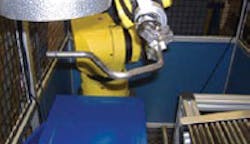Automated Cell Re-Invents Tubular Fabricating
The Uni-vercell automated tube-bending cell could possibly rewrite the economics of fabricating tubular components for high-volume applications such as those associated with the automotive industry, the cell’s developer Unison said.
The cell, which is available in North America through Horn Machine Tools, provides a complete end-to-end loading/end forming/ bending and vision inspection process in a footprint typically required for a standalone tube-bending machine. With an all-electric machine architecture, the system centers on an articulated robot arm.
“We’ve developed automated cells in the past around our standard tube-bending machines. With Uni-vercell, we designed the system from the ground up, replacing the machine’s carriage with a standard robot arm,” Mike Lawson, project manager with Unison, said.
He went on to say that the robot makes the cell much more compact and gives perfect accuracy and repeatability because the arm retains the part for the duration of the process, and every part is inspected. The design eliminates a lot of hardware, and by exploiting the vertical space, the company has effectively packed three machines into the space of one.
Unison’s first implemented Uni-vercell fabricates tubular parts with diameters up to 0.750 in. and takes up only 48 sq. ft. The machine includes a tube loader, 6-axis robotic arm with a 13.23-lb payload, 2-stage end former, a multi-stack mandrel-less tube bender, and vision system. With the integrated vision system, the machine operates unmanned while providing 100 percent inspection of bend angles and endform shapes. System programmability also makes it easy to integrate further functions such as product labeling, which can be easily fitted into the extensive vertical space.
Two major innovations are at the heart of Univercell. The first is the replacement of a tube bender’s carriage with the articulated robotic arm. Sporting a simple collet that grips and rotates tubular parts, the arm can hold and manipulate workpieces continuously from pick up, through end forming, tube bending and inspection, to final release. This not only eliminates the cost of the carriage and the large required space for it, but also does away with numerous intervening reference points, jigs and handling equipment that might normally be involved with building a cell from discrete components.
The second major innovation is the allelectric end former for software-controlled, two-stage end forming (flaring and compressing). Compared with conventional hydraulic end formers, this design eliminates the pump and tubing and associated noise, heat, energy consumption and environmental issues.
Uni-vercell fabricates parts to an overall accuracy of 0.1 mm, and although the cell is optimized for repetitive volume applications, the flexibility of the robot arm allows it to be configured for batch production as well. The system’s driftfree performance lets shops set up to fabricate parts by simply loading a program, rather than making and scrapping trial parts until the configuration is right.
